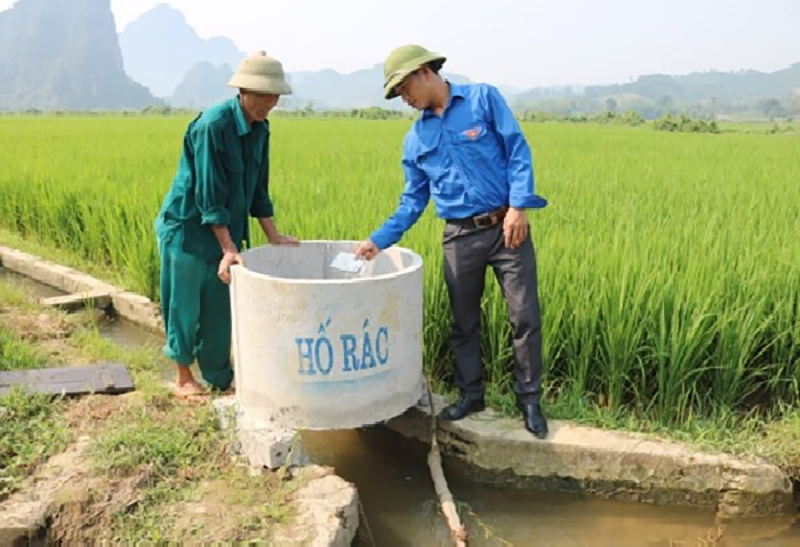In 2022, the export turnover of the entire agricultural industry will reach more than 53.22 billion USD, with a significant increase in the fields of agriculture, forestry, animal husbandry and fisheries. Along with the positive aspect, the development of the agricultural industry also puts great pressure on the environment, including the problem of plastic waste in the industry. Therefore, limiting the use of plastic waste is a requirement to protect the environment, for the agricultural industry to develop sustainably, and to improve the reputation of Vietnamese agricultural products.
Many models to reduce plastic waste
According to the National State of the Environment Report, the total amount of solid waste (including plastic waste) arising from cultivation is currently about 661.5 thousand tons/year (including 550 thousand tons of plastic, 77.49 thousand tons of bags). fertilizer packaging and 33.98 thousand tons of pesticide packaging). Solid waste generated from livestock is 67.93 million tons, of which plastic waste is 77 thousand tons from animal feed packaging. Solid waste from aquaculture is 880 thousand tons of sludge and 273 thousand tons of waste from food packaging, veterinary medicine shells and other solids.

Mai Thanh Giang, Director of the Sub-Department of Cultivation and Plant Protection of Thai Binh province, said that for rice production alone, on average, about 1-1.5kg of plastic waste is emitted/ha/year, while for rice production, on average With vegetables, the amount of plastic waste from pesticide packaging is higher, 2-3 times higher than rice cultivation.
In order to reduce plastic waste into the environment, Thai Binh province has implemented and replicated the model of "Clean field-collecting pesticide packaging" in most communes and towns to invest, build a More than 4,500 tanks for pesticide packaging and put into operation in the fields to sort plastic waste at source and collect and treat according to regulations. These packages will be collected by the Department of Natural Resources and Environment of Thai Binh province from tanks in the fields. Then hire a unit with the function of treating this waste source. At the same time, all districts in the province are currently funded to use rat poison at the same time to protect crops with the specific goal of not using plastic to surround rice fields to reduce the amount of garbage and plastic waste. In addition, for the rice harvest, the agricultural sector also recommends that farmers limit the use of plastic bags to store rice.
PLASTIC WASTE RECYCLED INTO TYPES OF CONSTRUCTION MATERIALS EXPRESSED AT A CONFERENCE ORGANIZED IN HANOI.
Currently, Quang Binh province has implemented a model of collecting and treating plastic waste with 700 offshore fishing vessels participating. According to Mr. Le Ngoc Linh, Director of the Fisheries Sub-Department of Quang Binh province, it is estimated that the collection of plastic waste on fishing vessels from offshore fishing in the province reaches about 60 tons/year, this figure is still very high. small and is only the first step compared to the requirement to collect plastic waste at sea from fishermen. However, if this amount of plastic waste is not treated and collected, it will directly affect the fisheries industry, which will affect the protection of aquatic resources.
In fact, in recent years, the situation of plastic waste used in aquaculture has adversely affected the environment in some localities. Mr. Do Dinh Minh, Director of the Fisheries Sub-Department of Quang Ninh province, said that the waste of foam buoys floating in the sea during aquaculture has had a negative impact on the marine environment and the landscape of Ha Long Bay. . Quang Ninh province had to mobilize forces and means to salvage and handle these foam buoys, and at the same time implement measures to protect the marine environment and the landscape of Ha Long Bay. The province applies the model of converting styrofoam in aquaculture to floating materials according to QCDP 08:2020/QN standards to help gradually replace disposable plastic materials that are difficult to collect and reuse with materials that can be reused. Recycled, environmentally friendly.
Contributing to improving the prestige of Vietnamese agricultural products
In order to successfully reduce plastic waste in agriculture and fisheries, Ms. Ramla Khalidi, Resident Representative of the United Nations Development Program (UNDP) in Vietnam recommends: Vietnam needs to develop data. Plastic pollution and plastic waste baseline and feasibility monitoring system from national to provincial level to assess the progress of plastic waste reduction in the agricultural sector. Along with that, it is necessary to promote efficient collection and recycling models, use packaging materials to replace single-use plastics in the field; and at the same time training farmers and agricultural stakeholders on the environmental impact of plastic and its alternatives.
Currently, there are a number of research projects, implementing the application of recycling plastic waste into raw materials for the production of building materials such as bricks, tiles, and roofing sheets. This is considered a fundamental solution to treat plastic waste in general and plastic waste in agriculture in particular to protect the environment.
Deputy Minister of Agriculture and Rural Development Phung Duc Tien said: Plastic waste is a big global problem that needs to be solved, including plastic waste in agriculture. Therefore, it is necessary to promote action solutions to reduce plastic waste in the agricultural sector in a systematic way, and at the same time, mobilize the resources of all parties to create a drastic change in production activities, towards towards the development of circular agricultural production, environmentally friendly and adaptive to climate change. Moreover, the reduction of plastic waste not only protects the environment in agriculture, but also contributes to improving the image, reputation and quality of Vietnamese agricultural products in the international market.